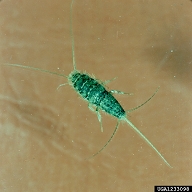Water vapor absorption and adsorption also requires surfaces. Thus, ignoring efficiency considerations for the moment, a larger amount of water vapor will be absorbed if a larger a surface area is available that is capable of absorbing water vapor.
The Surface Law
 |
| A cube with sides of length 's' Source: tutornext.com |
- A cube 1 unit in size (s=1), has volume equal to1 and surface area equal to 6. Its ratio of surface area/volume is 6
- A cube 2 units in size (s=2), has volume equal to 8 and a surface area equal to 24. Its ratio of surface area/volume is 3
- A cube 4 units in size (s=4), has a volume equal to 64 and surface area equal to 96. Its ratio of surface area/volume is 1.5
Tracheal System
 |
| source: users.rcn.com. |
Pores
Nature invented pores to increase surface area.
 |
 |
| source: the poultrysite.com |
The pore size (17 micro-mm) has been optimized to provide the large amount of oxygen required just prior to hatching.
The Human Respiratory System
 |
| Source: Goldiesroom.org |
As body size increases, the complexity of providing enough surface area to all the tissues and cells in the body increases.
- Oxygen is extracted from the air we breathe at the surfaces of miniature air sacs (alveoli) in the lungs
- This oxygen diffuses from the blood into a cell at the surface of a capillary
The human system to move oxygen into the body and remove carbon dioxide from the human body increases in complexity by creating new surface areas with specialized functionality that feeds nutrients to cells and extracts waste for disposal.
A Gram with Surface Area of 2 Basketball Courts
 |
| Source: physorg.com |
The green balls are hydrogen molecules that this design is optimized for.
A gram of MOF-74 has the surface area of 2 basketball courts
Many many more examples exist of structures created by nature and mankind for supplying cells with nutrients and removing waste. So what would a structure look like that presents enough surface area to withdraw water vapor from unsaturated air?








